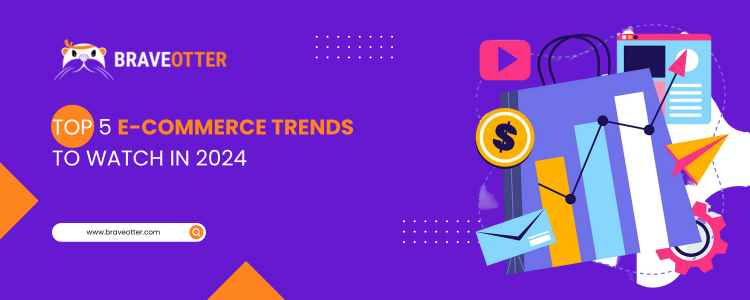Top 5 E-commerce Trends to Watch in 2024

As e-commerce keeps changing, businesses need to stay on top of new trends to stay competitive in 2024. With new technology and changing shopping habits, the way people shop online is set to evolve even more. In this article, we’ll look at the top five e-commerce trends that will shape the industry in 2024. Whether you’re experienced or just getting started, knowing about these trends can help your business grow and succeed in the year ahead.
AI-Driven Data Collection and Enhanced Conversion Rates
In 2024, e-commerce businesses are moving towards AI to improve user experience, engagement, and conversion. AI can help a lot in users’ shopping experience, reducing abandoned carts, improving product discovery, facilitating better search results, etc which would effectively improve the conversion rate. In e-commerce business, the fight is only about increasing the conversion rate and AI can play a vital role here. BraveOtter, which is a product discovery tool, is a good example of preparing data collection for both small and vast e-commerce catalogs and generates results with the speed of light.
Personalized Shopping Experiences with AI-Enhanced Product Recommendations
The customer of today’s generation is more advanced and looking forward to getting the results quickly if you talk about any sector. To achieve the expectations of the customer of this and future generations, it is important to be prepared if not and improve if you are already doing it. As suggested above, AI is definitely the future but it is important that how smartly you use AI for the conversion and better user experience. Each customer is looking forward to finding the things they want and seeing the results according to their need. AI can help here to get things personalized for them by understanding the customers’ browsing history, search patterns, and shopping history. The data personalization includes the following –
- Relevant Product Recommendations
- Customized Layout of Store
- Targeted Discounts
- Content Based on Location
- Improved Search Results
Customer Engagement and Relationship
The customer engagement and good relationships are always the keys to the businesses of any sector. This is not a new trend while this is a fixed trend of any market and that is the reason for having this trend placed in this article. Obviously, the style and ideas behind the engagement and relationship will keep on changing but the ultimate goal will always be the same in any generation. A few of the ideas are shared below which you can apply in your business for improvements and better customer engagement –
According to a study by Bain & Company, increasing customer retention rates by 5% can increase profits by 25% to 95%.
Improved UI/UX Experience
It is very important that if a user comes to your online store, he should be able to connect with the given user interface and experience. Here, the main things are Product Discovery, Search and the Design. The UI/design of your store should be clean with no distracting elements and the product discovery should be easiest in terms of seeing the listings or applying any search.
Personalized Communication
Customers can be engaged using personalized communication like emails, messages, WhatsApp channels, etc. It makes them feel valued and understood. Newsletters can also be a part of this idea where you can ask them to subscribe and start sending the regular emails informing them about the new catalog, promotions and offers etc.
Responsive Customer Support
The customer support is very important and essential as it majorly comes into the picture after conversion. It is easy to get the conversion once but it is difficult to get the customer intact with you for repeat sales from the returning customers. For this, the support should be there to help them in placing orders, tracking the orders, getting reviews, etc. It is a simple theory that if the customer gets a good service then there is a high chance that the customer will give you repeat sales. Around 93% of customers are likely to make repeat purchases with companies that offer excellent customer service, according to HubSpot.
Social Media Engagement
Social commerce, which integrates social media and e-commerce, has transformed how businesses connect with customers. Facebook and Instagram in the social commerce landscape, where together, they account for about 90% of social commerce sales.
Facebook itself accounts for approximately 70% of social commerce sales globally, making it the leading platform for social commerce while Instagram contributes around 20% of social commerce sales.
Headless Commerce
Headless commerce is an e-commerce setup where the front-end (the customer-facing part) is separate from the back-end (where business logic and data management happen). This separation lets businesses design unique and adaptable experiences for different channels like websites, mobile apps, social media, and IoT devices, without being limited by a single platform’s restrictions.
Key benefits of Headless Commerce –
- Customization and Flexibility
- Omnichannel Experiences
- Faster Time-to-Market
- Enhanced Performance
- Scalability
Expanding Flexible Payment Options to Reduce Cart Abandonment
Offering flexible payment options is crucial for enhancing customer satisfaction and increasing sales. By providing a variety of payment methods, such as credit/debit cards, digital wallets, bank transfers, and buy now, pay later services, businesses can cater to different preferences and needs.
In 2023, global e-commerce sales reached approximately $6.5 trillion, demonstrating the increasing reliance on online shopping and the need for robust online payment systems.
This flexibility not only improves the overall shopping experience but also helps in reducing cart abandonment rates.
Here are some key facts from 2023 that highlight the importance of online payments:
Digital wallets, such as Apple Pay and Google Pay, saw significant growth. By 2023, over 40% of global online transactions were made through digital wallets, reflecting their importance in consumer payment preferences.
BNPL (Buy Now, Pay Later) services grew in popularity, with transactions in this category increasing by over 25% compared to the previous year. This indicates a shift in consumer preference towards flexible payment options.

